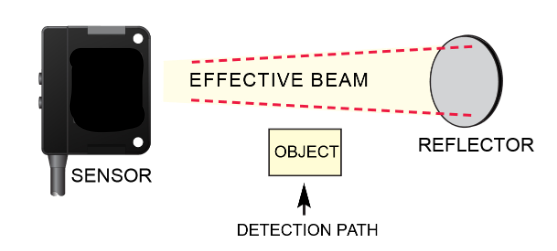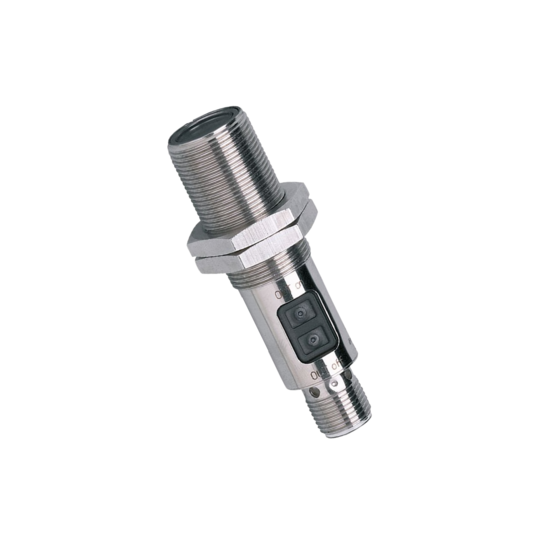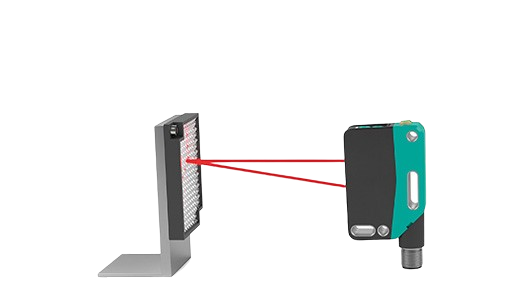What is a photoelectric retro-reflective sensor?
10.10.2024
Precise and reliable object detection is critical for ensuring smooth and efficient operations. One of the most effective tools for this task is the photoelectric retro-reflective sensor. But what exactly is it, and why is it so important?
A sensor that uses light to determine whether things are present or absent is called a photoelectric retro-reflective sensor. A light beam is directed towards a reflector, which returns the light to the sensor, in order for it to function. The sensor detects the disruption of the light beam caused by an object passing through and initiates a response or action. Because these sensors provide great precision, a large detection range, and versatility in a variety of situations, they are highly sought in industrial applications.
In the field of industrial automation, sensors like these play a vital role in optimizing processes, reducing downtime, and ensuring safety. Whether in manufacturing, packaging, or security systems, photoelectric retro-reflective sensors are essential for maintaining productivity and reliability in complex automated systems. Their ability to detect objects over long distances and in challenging conditions makes them indispensable for modern industries.
How Does a Photoelectric Retroreflective Sensor Work?
A sophisticated tool that uses the principle of light reflection to determine whether an object is present or absent is a photoelectric retroreflective sensor. This kind of sensor uses a retroreflective target to reflect light back to the receiver and combines the light emitter and receiver into a single unit. Here's a detailed breakdown of its operation:
1. Basic Principle of Operation
The core idea behind a photoelectric retroreflective sensor is the reflection of emitted light. The process starts with the light emitter, which sends out a beam of light. This light beam is directed towards a retroreflective target, typically a specialized reflector designed to bounce the light back. When there is no object in the path, the light travels uninterrupted to the reflector and back to the sensor's receiver. The receiver, upon detecting the reflected light, maintains a constant electrical signal.
When an object crosses the light path, it interrupts the beam. This interruption leads to a significant reduction in the amount of light reaching the receiver. The sensor detects this drop in light intensity and triggers an output signal, indicating the presence of an object.

2. Components Involved
To understand the functioning of a photoelectric retroreflective sensor more deeply, it's essential to consider the various components involved:
Light Emitter: This is the part of the sensor that emits a beam of light. The light can be in the infrared spectrum to avoid visible interference or other optical wavelengths. The emitter can produce either a continuous or a modulated light beam, which helps in distinguishing the emitted light from ambient light.
- Receiver: Positioned within the same housing as the emitter, the receiver's role is to detect the light that is reflected back from the retroreflective target. It converts the light signal into an electrical signal that the sensor's circuitry can process.
- Reflector: The reflector, or retroreflective target, is placed opposite the sensor. It is specifically designed to reflect the light beam back to its source with minimal scattering. The high efficiency of retroreflective targets ensures reliable detection by the sensor.
- Housing: The emitter and receiver are enclosed in a protective housing, which shields them from dust, moisture, and mechanical damage. This housing also ensures proper alignment and operation of the sensor components.
- Power Supply: The sensor requires a power source to operate the emitter and receiver. The power supply needs to be stable to ensure consistent performance.
- Output Interface: The output interface of the sensor can vary depending on its application. Commonly, it includes electrical outputs such as relays or transistors that trigger specific actions, like stopping a conveyor belt or activating an alarm, when an object is detected.
Key Features of Photoelectric Retro-Reflective Sensors
Photoelectric retro-reflective sensors are indispensable in various applications due to their unique features. Here’s a deep dive into some of their key attributes:
High Accuracy
The great precision of photoelectric retro-reflective sensors is well known. This is because when an item obstructs the reflected light beam, they may sense even the smallest variations in light intensity. These sensors' accuracy guarantees dependable detection, which makes them perfect for usage in settings like assembly lines and quality control systems where accurate object detection is essential.
Long Sensing Distance
One of the standout features of photoelectric retro-reflective sensors is their long sensing distance. These sensors can effectively detect objects over several meters, depending on the model and reflector used. This long-range detection capability makes them suitable for applications where other sensors might fail, such as in large-scale manufacturing setups, warehouses, and material handling systems.
Easy Alignment
Compared to other types of sensors, photoelectric retro-reflective sensors are relatively easy to align. Unlike through-beam sensors, the emitter and receiver are contained within the same unit, therefore they are not need to be precisely aligned with one another. Utilizing a retroreflective target streamlines the setup process even further because it may reflect light back to the sensor from an array of angles, cutting down on installation complexity and time.
These features—high accuracy, long sensing distance, and easy alignment—make photoelectric retro-reflective sensors a versatile and reliable choice for diverse industrial and automation applications. They offer efficiency and effectiveness, ensuring smooth operations and enhanced productivity.
Types of Photoelectric Retro-Reflective Sensors
Photoelectric retro-reflective sensors provide a variety of functions to meet the needs of various applications in industrial automation. Detailed look at various types of these sensors:
1. Standard Retro-Reflective Sensors
These are the most common type, featuring a simple setup where the sensor and the reflector are aligned. They work effectively in clear and stable environments, detecting objects by the interruption of the light beam.
Applications:
- Conveyor belt monitoring
- Packaging systems
- General presence detection
2. Polarized Retro-Reflective Sensors
A polarized filter is used on both the transmitter and the receiver of polarized retro-reflective sensors. When it comes to differentiating between the light reflected from the reflector and any reflections from the bright surfaces of the items being detected, this configuration works incredibly well. When things have reflective surfaces, they guarantee greater precision.

Applications:
- Detection of bottles or cans in a production line
- Sorting of metallic objects
- Situations with high background light interference
3. Background Suppression Retro-Reflective Sensors
These sensors are made to only focus on the chosen target, ignoring reflections from surrounding objects. They are equipped with advanced optics and signal processing to differentiate between the reflector and any other reflective surface within the range.

Applications:
- Complex environments with varying background conditions
- Automated assembly lines
- Quality control checks
4. Fiber Optic Retro-Reflective Sensors
Fiber optic retro-reflective sensors are perfect for confined spaces or dangerous situations where ordinary sensors cannot fit or function securely. They transmit and receive light via fiber optic cables. These sensors can work well in challenging environments like extremely high or low temperatures since they employ fiber optics.
Applications:
- Detection in confined spaces
- High-temperature environments
- Areas with high electromagnetic interference
5. Laser Retro-Reflective Sensors
Using a laser as the light source, laser retro-reflective sensors offer excellent precision and a longer detection range for small objects. These sensors are appropriate for applications needing accurate detection because of the superior accuracy provided by the concentrated and coherent laser beam.

Applications:
- Precision measurement and positioning
- Detection of small or thin objects
- High-speed sorting and counting
Each type of photoelectric retro-reflective sensor brings unique advantages tailored to specific industrial needs, enhancing operational efficiency and ensuring reliable object detection across various environments.
Comparison with Other Types of Sensors
Photoelectric retro-reflective sensor stands out for its unique capabilities and versatility. But what exactly is a photoelectric retro-reflective sensor, and how does it compare with other sensor types like proximity and ultrasonic sensors?
Photoelectric retro-reflective sensors use light reflection to determine if an object is present or absent. They are composed of a light source and a receiving device integrated into one unit that cooperate with a target that reflects light backward. When an object breaks the laser beam, this target reflects the light back to the sensor, enabling it to detect it. This technique is very useful in many situations where precise item detection is critical, such as automated assembly lines and packing lines.
Photoelectric vs. Proximity Sensors
Inductive and capacitive proximity sensors can identify items even when they are not in close proximity to one another. While capacitive proximity sensors may identify both metallic and non-metallic items by detecting changes in capacitance, inductive proximity sensors employ electromagnetic fields to detect metallic things. As an alternative, photoelectric retro-reflective sensors have the benefit of greater material detection range and longer sensing distances, which makes them appropriate for a variety of industrial settings.
Photoelectric vs. Ultrasonic Sensors
Ultrasonic sensors measure the time it takes for an object's echoes to return to the sensor after being exposed to sound waves. They can function in challenging conditions like dust or fog and are efficient at identifying transparent or reflecting objects. On the other hand, ultrasonic sensors could struggle with very small objects and have slower response times than photoelectric retro-reflective sensors. More precision and higher detection speeds are offered by photoelectric retro-reflective sensors, especially in high-speed automation operations.
How to Choose the Right Photoelectric Retro-Reflective Sensor
Selecting the right photoelectric retro-reflective sensor for your industrial application involves careful consideration of various factors to ensure optimal performance and reliability.
1. Application Requirements
Start by defining the specific needs of your application:
- Type of Object: Determine the nature of the objects you need to detect (size, shape, color, material). Reflective, transparent, or shiny objects may require polarized sensors.
- Detection Range: Identify the maximum and minimum distances at which the sensor needs to detect objects. Ensure the sensor’s range matches your requirements.
2. Environmental Conditions
Consider the operating environment where the sensor will be installed:
- Ambient Light: Ensure the sensor can handle varying light conditions without false triggering. Polarized sensors can mitigate issues caused by reflective surfaces.
- Temperature: Verify the sensor’s operating temperature range aligns with the environmental conditions.
- Dust and Moisture: Choose sensors with appropriate IP ratings for protection against dust and moisture if the environment is harsh.
3. Sensor Features
Evaluate the features of different sensors to match your needs:
- Sensitivity: Adjustable sensitivity can be crucial for detecting different object sizes and materials.
- Response Time: Consider the speed at which the sensor can detect and respond to an object, especially in high-speed automation.
- Housing Material: Ensure the sensor's housing material is suitable for the environmental conditions (e.g., stainless steel for corrosive environments).
4. Mounting and Alignment
Assess the ease of installation and alignment:
- Mounting Options: Check the available mounting brackets and accessories. Ensure they are compatible with your setup.
- Alignment Ease: Choose sensors that are easy to align, especially if frequent adjustments are necessary.
5. Electrical Specifications
Ensure compatibility with your system’s electrical requirements:
- Voltage Supply: Verify the sensor’s voltage range matches your power supply.
- Output Type: Determine if you need NPN, PNP, or relay outputs based on your control system.
6. Cost and Reliability
Finally, balance cost with reliability and longevity:
- Budget Constraints: Consider the sensor’s price while ensuring it meets all your application needs.
- Reliability: Opt for reputable brands and models with a proven track record of performance and durability.
By carefully considering these factors, you can select a photoelectric retro-reflective sensor that fits seamlessly into your industrial setup, ensuring accurate and reliable detection for enhanced productivity and efficiency.
Common Issues and Troubleshooting in Photoelectric Retro-Reflective Sensors
Even with their robust design, photoelectric retro-reflective sensors can encounter issues. Knowing the common problems and their solutions can help maintain smooth operations in industrial automation settings.
| Common Issues | Possible Causes | Troubleshooting Tips |
| False Detections or Missed Objects | Ambient light interference, reflective surfaces, dust accumulation | Adjust sensitivity, use polarized models, clean sensor and reflector |
| Inconsistent Detection | Misalignment, vibrations, fluctuating power supply | Check alignment, secure mounting, stabilize power supply |
| No Detection | Misalignment, damaged components, incorrect wiring | Inspect wiring, test sensor output, replace damaged components |
| Short Detection Range | Obstructed light path, low sensor power, unsuitable reflector | Clear obstructions, verify power supply, use proper reflector |
| Intermittent Output | Electrical noise, poor connections, software glitches | Use shielded cables and proper grounding, inspect connections, update software |
| Sensor Not Responding | Defective sensor, improper installation | Replace the sensor, review installation procedure |
| Erratic Behavior in High Ambient Light | High intensity light sources interfering | Use filters or shades to minimize ambient light interference, consider moving the sensor |
| Slow Response Time | Outdated sensor technology, environmental factors | Upgrade to a sensor with faster response time, ensure optimal environmental conditions |
| Reflector Issues | Dusty or damaged reflector, improper alignment | Clean or replace the reflector, realign properly |
| Unstable Readings in Extreme Temperatures | Sensor not rated for temperature extremes | Use sensors rated for the specific temperature range, ensure proper thermal management |
How to Maintain a Photoelectric Retro-Reflective Sensor
Maintaining your photoelectric retro-reflective sensor is crucial for ensuring its longevity and reliable performance in industrial applications. Regular maintenance can help prevent unexpected downtime and keep your automation system running smoothly.
1. Regular Cleaning
- Sensor and Reflector: Dust, dirt, and debris can accumulate on the sensor lens and the reflector, affecting their performance. Use a soft, lint-free cloth to clean the surfaces regularly. For stubborn dirt, a mild soap solution can be used, but avoid harsh chemicals that might damage the lens or housing.
- Avoid High-Pressure Cleaning: While cleaning, avoid using high-pressure sprays as they can force water into the sensor housing, potentially causing damage.
2. Check Alignment
- Sensor and Reflector Alignment: Ensure that the sensor and reflector are properly aligned. Misalignment can lead to false detections or missed objects. Periodically check the alignment, especially if the sensor is subject to vibrations or mechanical impacts.
- Adjustment: Use the built-in adjustment mechanisms to fine-tune the alignment. Many sensors have alignment indicators or LEDs to assist with this process.
3. Inspect Electrical Connections
- Wiring and Connectors: Regularly inspect the wiring and connectors for signs of wear, corrosion, or damage. Ensure all connections are secure and free from moisture.
- Check Power Supply: Verify that the sensor is receiving a stable power supply within the specified voltage range. Fluctuations or interruptions in power can affect sensor performance.
4. Monitor Sensor Performance
- Output Signals: Keep an eye on the sensor’s output signals. Any irregularities or inconsistencies in the output can indicate potential issues with the sensor or its environment.
- Diagnostic Tools: Use diagnostic tools provided by the manufacturer, if available, to monitor the sensor’s performance and troubleshoot any problems.
5. Environmental Considerations
- Temperature and Humidity: Ensure the sensor is operating within its specified temperature and humidity range. Extreme conditions can impact sensor performance and longevity.
- Protective Housing: If the sensor is used in a harsh environment (e.g., high temperatures, moisture, dust), consider using protective housings or covers to shield it from these conditions.
6. Replace Worn Components
- Reflector: Over time, the reflector can become worn or damaged, affecting its ability to reflect light accurately. Replace the reflector as needed to maintain optimal sensor performance.
- Sensor Lens: Inspect the sensor lens for any scratches or damage. If the lens is compromised, it may need to be replaced to ensure accurate detection.
7. Scheduled Maintenance
- Routine Checks: Implement a regular maintenance schedule to inspect and service the sensors. This can help identify and address issues before they lead to sensor failure.
- Documentation: Keep detailed records of maintenance activities, including cleaning, alignment checks, and component replacements. This documentation can be useful for troubleshooting and future reference.
Conclusion
Photoelectric retro-reflective sensors are integral components in the realm of industrial automation. Their ability to detect objects with high precision, over long distances, and in varied environmental conditions makes them invaluable. By utilizing a retroreflective target, these sensors can offer reliable performance with minimal installation and alignment challenges. Understanding their operation, benefits, and how they compare with other sensor types, such as proximity and ultrasonic sensors, equips you with the knowledge to make informed decisions for your automation needs. Ensuring regular maintenance and addressing common issues will keep these sensors functioning optimally, contributing to increased efficiency and productivity in your industrial applications.